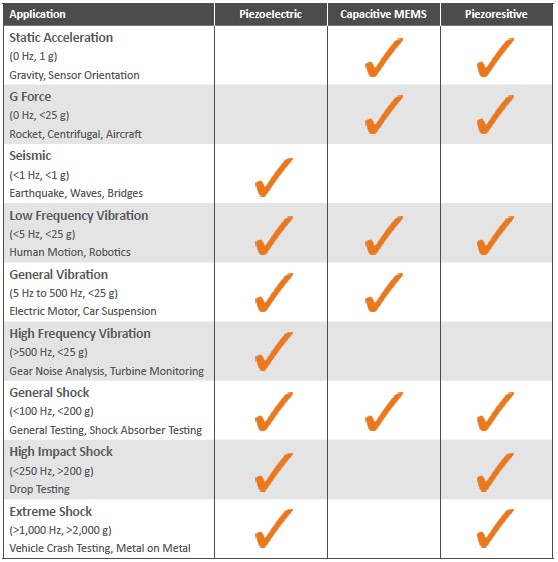
Accelerometers are widely used to monitor vibration in aerospace, automotive and manufacturing applications. Mechanical engineers often use them to diagnose problems with rotating equipment or assess the stability of structures that are subject to periodic stresses (such as monitoring the vibrations caused by trains/trucks crossing bridges, etc.) They are also often used in monitoring for condition-based maintenance, allowing engineers to examine the vibrations produced by a piece of equipment to assess its health, and monitoring the stresses sensitive equipment undergoes during transportation.
This blog will discuss and compare several different accelerometer types that can be used for vibration measurement. And for a deeper dive, read our handbook on Vibration Measurements.
The most common method of acquiring vibration data involves connecting accelerometers and configuring them into a data acquisition system that can deliver high-resolution (24-bit) vibration data at very high sample rates. Modern data acquisition systems can plot, log, filter, and analyze vibration data in real time, and allow using a variety of accelerometer types. They can even allow for wireless streaming of vibration data over Wi-Fi if properly configured.

When mounted directly on (or in) a vibrating structure, an accelerometer proportionally converts mechanical energy to electrical energy. Acceleration is generally represented with the gravitational constant g, which equals 9.81 m/s2. Three main types of accelerometers are used for vibration test.
Piezoelectric Accelerometers
Piezoelectric accelerometers are the most popular and widely used for industrial applications. Their lead zirconate titanate (PZT) sensing elements produce electric charge or output under acceleration. Piezoelectric accelerometers have very low noise and offer performance superior to capacitive MEMS or piezoresistive accelerometers in all vibration and most shock applications. Many variants are available: triaxial or single axis, from high sensitivity types for seismic applications down to low sensitivity for shock testing; some types are designed to handle the most extreme environments, even nuclear ones. Their most significant downside is that they are AC coupled, so they can’t measure the gravity vector or sustained accelerations.
Charge Mode Piezoelectric Accelerometers
Charge mode piezoelectric accelerometers are extremely durable because of their ability to withstand hostile conditions, including extreme temperatures (-200°C to +400°C); some can even operate in nuclear environments. However, their high impedance requires the use of special cabling for noise shielding. A charge amplifier is also required, which adds to system cost and complexity.
Voltage Mode Internal Electronic Piezoelectric Accelerometers
Voltage mode Internal Electronic Piezoelectric (IEPE) accelerometers have become the most commonly used accelerometer type. They are very similar to charge mode piezoelectric accelerometers but include a built-in charge amplifier. That eliminates the need for special cabling and simplifies integrating them into a system. A constant DC power source is required, which many data acquisition systems now include. The microelectronic circuit built into these accelerometers means they can’t match a charge mode accelerometer’s ability to tolerate hostile environments, but their typical temperature range of -40° to +125°C is sufficient for the majority of applications. As with any type of sensor, ensuring vibration measurement accuracy depends on choosing the right accelerometer for the specific application. In many cases, the accelerometer is the most critical link in the measurement chain. For example, for shock testing that requires integrating the acceleration data for velocity or displacement, choose either a capacitive MEMS or piezoresistive accelerometer. Piezoelectric accelerometers are ideal for vibration measurement, but special high sensitivity accelerometers are needed for lower frequency applications. Table 1 offers guidelines on which accelerometer type is best suited to various applications.
Variable Capacitance MEMS
Variable Capacitive MEMS (micro-electro-mechanical systems) accelerometers are the smallest and least expensive accelerometer options and are often used in smart phones. They can be mounted directly to printed circuit boards, which has made them electrical engineers’ preferred choice. Although their low cost and small size have made them popular, they offer significantly lower data quality, especially on the higher frequency and amplitude end. They are generally unsuitable for industrial applications; but they are a DC coupled and a great option for human-based applications. Their low cost and power consumption also make them a good choice for health monitoring.
Piezoresistive Accelerometers
Piezoresistive accelerometers are the foremost type for shock testing, but they are preferred for vibration measurement. Because they are based on strain gauges, they require the use of amplifiers and temperature compensation, they offer very wide bandwidth (from 0 to several thousand hertz) and low noise characteristics. They can be gas or fluid damped, which protects the accelerometer and prevents it from reaching its internal resonant frequency. Because they are DC coupled, their output can be integrated to calculate velocity and displacement during shock events.
Summary
The following table provides a summary of how to select the right accelerometer for your application.

To learn more about choosing the right accelerometer for your application, read our handbook on Vibration Measurements or contact us if you want help in configuring your next accelerometer application.
For more on this topic, visit our dedicated Wireless Sensors resource page. There you’ll find more blog posts, case studies, webinars, software, and products focused on your wireless accelerometer testing and analysis needs.
